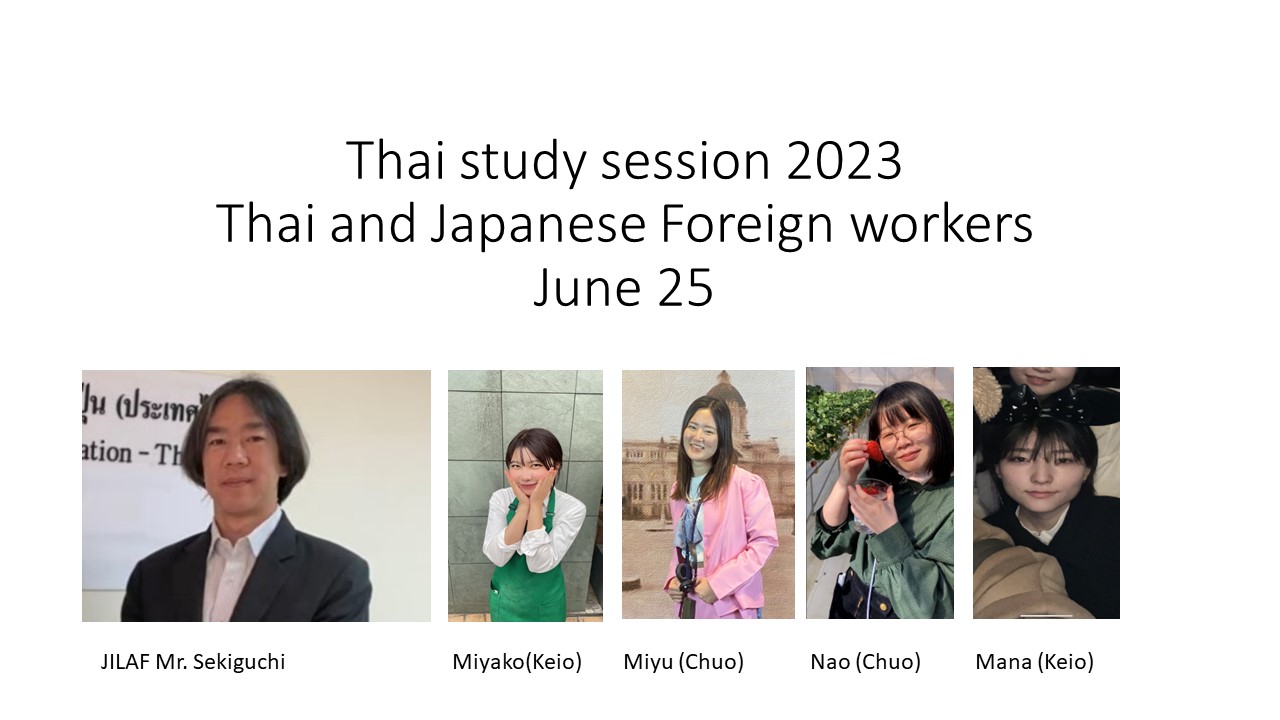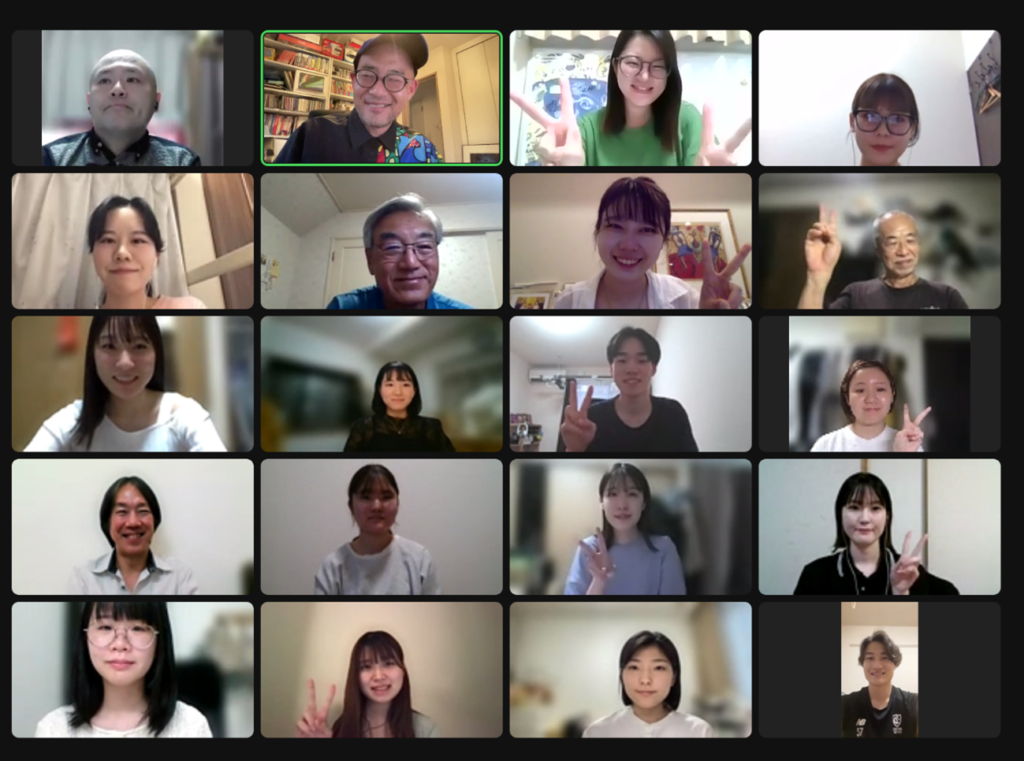2023 Thai Study Session “Thai and Japanese Foreign Workers”

We had a Thai study session on June 25th. The theme is about “Thai and Japanese Foreign Workers”. 20 students including Chuo University, Keio University, Hitotsubashi University and some others participated in this session. This time, the students made a research presentation on how many foreign workers will be needed in the future due to the declining population of Japan and Thailand, the declining birthrate and aging population, and the decline in the working population. A seminar was held on the status of acceptance and problems of foreign workers, and the system for accepting foreign workers in Japan by Mr. Sekiguchi from JILAF. After that, we had a study session where all the participants discussed this issue. Ms. Takase from Keio University acted as moderator.
1) Japan’s Declining Population and Foreign Workers
Ms. Fukuzawa from Chuo University, Ms. Takase and Ms. Fukuzawa from Keio University made a graph based on their research and presented the following.
1. Japan’s population will drop from 126 million in 2020 to 87 million by 2070. The birth rate is currently around 1.41. In the future, the working-age population will decrease rapidly and it becomes prominent that there will be labor shortages in various fields.
2. The current number of foreign workers in Japan has surged to 1.82 million. According to a survey by JETRO, the current economic growth cannot keep up without accepting 4.19 million foreign workers in 2030 and 6.74 million in 2040.
3. Currently, a technical internship program is in place for the purpose of transferring technology overseas, and there are many problems such as the maximum period of stay is 5 years, living alone, and not being able to change jobs, so the Japanese government is reviewing the system.
2) Population Decline in Thailand and Foreign Workers
Ms. Ishida of Chuo University made a presentation on the results of her research on Thailand’s declining birthrate, aging population, and the current situation of foreign workers.
1. The current population of Thailand is about 71.6 million, but the population is declining and aging, and the current birth rate is as low as 1.1.
2. The number of foreign workers in Thailand is said to be about 2.74 million. Workers from Myanmar account for 63%. However, there are many foreign workers for whom statistics are not taken. They mainly work in construction, agriculture, animal husbandry, services and manufacturing. The influx of foreign workers from neighboring countries has become conspicuous due to the fact that Thailand’s economy continues to grow and there is a labor shortage, and because it is possible to secure better wages than in the home country. However, it must be said that Thailand relies on foreign workers for heavy labor with low wages and poor working conditions.
3) Realization of a Multicultural Society that Includes Foreign Workers
Following the presentations by the students, the following seminar was held by Mr. Sekiguchi, Director of JILAF Thailand Office.
1. As the students announced, both Japan and Thailand are facing a declining birthrate and an aging population, and both countries are in a situation where they have no choice but to accept foreign workers. Looking at the world as a whole, the number of immigrants will reach 281 million in 2020, more than triple the number 50 years ago.
2. In Thailand, the number of foreign workers whose statistics are taken is 2.74 million, about 4% of the total population, but the actual number of immigrants is said to be about 5 million, and about 7% of the total population is occupied by foreign immigrants. Thailand has a long history of economic growth by accepting large numbers of foreign workers from neighboring countries. The Thai government is strictly managing the country, such as restricting the purchase of land, houses, etc. by foreigners. It also stipulates in detail the minimum wages for foreign workers by country of origin. Currently, there are many issues regarding the acceptance of foreign workers, but the Thai government fully understands that foreign workers support the foundation of Thailand’s economic growth. The acceptance environment has been changed flexibly for each problem.
3. Japan has not accepted foreign workers for a long time. In 2010, the number of foreign workers was 650,000, only 0.5% of the total population. With the start of the Technical Intern Training Program, the number has increased to 1.82 million in 2020, or about 1.4% of the total population. As explained above, the current Technical Intern Training Program has many problems and needs to be improved in the future. Japan has not yet established a system for accepting immigrants. In the future, if an influx of foreign workers is expected, as the student announced, Japan needs to reconsider accepting foreigners and improve the system and environment.
4. From now on, Japan needs to systematically accept foreign workers and make efforts to realize a multicultural society. It is important to be interested in and understand foreign countries and foreigners, and it is necessary to prepare laws, systems, and structures for accepting foreigners, including immigration laws. At the same time, it is necessary to improve the living environment, education, hospitals, and working environment to accept foreigners and their families.
4) Q&A
Questions were asked by the participants, and Mr. Sekiguchi responded as follows.
Question 1: What measures are taken in Thailand regarding the education and living environment of foreign workers and their families?
→Answer
The Thai government is creating a system that allows foreign children to receive the same compulsory education as Thais. In addition, they are now able to receive the same medical system as Thai people. However, the economic disparity in Thailand is so large that it cannot be compared with Japan, and it is not necessarily true that Thais and foreigners receive the same level of education. There are many children who cannot go to school because of poverty.
Question 2: Recently in Japan, it has become a problem that Sri Lanka died due to poor treatment at the time of immigration. What do you think?
→Answer
Japan is reluctant to accept refugees and has unclear screening criteria for refugees. The acceptance criteria should be clarified because the residence time for the examination is too long. The other day, there was a Japanese school official who used the expression refugee aristocrats to refer to Ukrainian refugees. The fact that he made a terrible remark but has not become a big problem since then shows Japan’s lack of interest in refugees.
Question 3: Do you have a Specified Skilled Worker System in Thailand?
→Answer
Thailand also has a system similar to the Specified Skilled Worker System. The Thai government has meticulously determined the types of jobs that foreigners can work in through MOUs, so as not to deprive Thais of their jobs. In Japan, they are considering expanding the number of occupations for Specified Skills 2 in the future. However, in Japan’s Specified Skilled Worker System, there are Japanese language and occupational exams, and the hurdles are higher than working in other countries.
5) Breakout Room Discussion
Participants were divided into groups of 4 to 5 people and discussed “How to accept foreign workers in Japan?” Here’s what we discussed in the breakout room:
1. We want to prevent a gap between the working environment of Japanese and foreigners. By establishing a salary increase system for foreign workers, we would like to be able to receive salaries according to their abilities.
2. We want to improve the training system for foreign workers to support their native language and understand life manners. Japanese people also need to improve their English skills.
3. Prior to the government’s response, the public’s awareness of a society of coexistence with foreigners should be improved. Regarding workers, it is necessary for Japan to have a good understanding of the countries to which foreign workers are dispatched.
4. In order for foreign workers to come and work in Japan, it is necessary to review and improve the working environment and living environment of foreign workers, as well as the acceptance of Japanese people. At the same time, efforts will be made to improve the English proficiency of Japanese people.
5. It is necessary to prepare a system to accept foreigners not only in Japanese cities but also in rural areas. It is necessary to provide information about Japanese language education and life in Japan online in advance, and to enhance mutual understanding rather than forcing Japanese culture.
Lastly, Mr. Sekiguchi, Mr. Komoriya, and Mr. Takahashi made the following comments.
Mr. Sekiguchi
Even if there is nothing that can be done about accepting foreign workers directly, it is important to start with what individuals can do, such as being aware of such problems.
Mr. Komoriya
Acting itself is not easy, but acting honestly based on your own understanding is also difficult. I hope that you will overcome these hurdles and take action.
Mr. Takahashi
Mutual understanding is necessary not only for the acceptance of foreign workers, but also for the acceptance of foreigners. As a step toward that goal, I hope that future student exchanges at OCA will deepen exchanges with other countries.
The seminar was held from 5:00 pm to nearly 7:00 pm Japan time. Lastly, we would like to share a group photo of everyone who participated.

